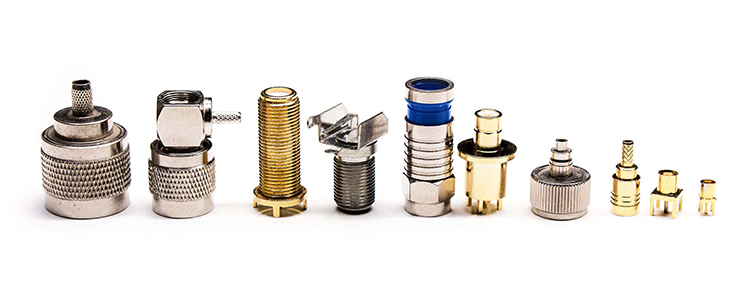BNC Connector
The full name of the BNC connector is Bayonet Nut Connector, a snap-on RF connectors. BNC connectors are widely used in wireless communication systems, television, test equipment, and other RF electronic equipment. Early computer networks were also used. The signal frequency range supported is 0 to 4 GHz, and there are 2 types of characteristic impedance: 50 Ohm and 75 Ohm.

SMA Connector
SMA is SubMiniature version A, which is a threaded RF connector. Invented in the 1960s, it has excellent performance, high reliability, and long life. It is suitable for connecting RF cables or microstrip lines in the RF circuits of microwave equipment and digital communication systems. The signal frequency range supported is 0 to 18 GHz, and some types can support up to 26.5 GHz. The characteristic impedance is 50 ohms.

SMB Connector
The full name of the SMB connector is SubMiniature version B, a push-in locking RF connector invented in the 1960s. The size is smaller than SMA connectors. Its small size, lightweight, ease to use, and excellent electrical properties make it suitable for connecting coaxial cables in the high-frequency circuit of radio equipment and electronic instruments. There are 2 types of characteristic impedance: 50 Ohm and 75 Ohm. It has excellent electrical characteristics in the frequency range from DC to 4GHz.

F-type connector
Eric Winston invented the F-type connector in the early 1950s. It uses the threaded RF connection, widely used in cable TV, satellite TV, cable TV modem, TV connection, etc. In the 1970s, it has become the connector of the common visible VHF TV antenna. The price is very low, the characteristic impedance is 75 ohms, and the highest frequency can generally support up to 1GHz or 2.4GHz.

N-type connector
Paul Neill invented the N-type connector in the 1940s, which uses a threaded connection. The supported signal frequency range is 0 to 11GHz, and the enhanced type can reach 18GHz. There are 2 types of characteristic impedance: 50 ohms (widely used in mobile communication, wireless data, paging system, etc.) and 75 ohms (mainly used in cable TV systems).

TNC Connector
TNC stands for Threaded Neill-Concelman and is a variant of the BNC connector. It adopts the threaded connection method, the characteristic impedance is 50 ohm, and the best working frequency range is 0-11GHz. in the microwave band, TNC connectors perform better than BNC connectors. It has strong vibration resistance, high reliability, excellent mechanical and electrical properties, etc. TNC connector widely used in radio equipment and electronic instruments to connect RF coaxial cables.

MCX Connector
MCX connector, whose full name is Mirco Coaxial, was invented in the 1980s and used a push-in connection method. It still has good electrical performance at frequencies up to 6GHz. It can be adapted to various cables, including semi-rigid and flexible cables, with a reliable connection and long life.


